Elizabeth Inglee-Richards's Blog, page 3
December 14, 2014
Arab; the first breed
A lot of ink has been spilled about the Arab horse. How old it is, how many breeds were developed from it, what you can do with it. For me the answers to that are; very old, most of them and everything.
The Arab is a small light horse with a high head and high croup. Many Arab Horses have 5 lumbar vertebra and 17 sets of ribs, one less than horses of other breeds.
[image error]
As a war horse the mares were ridden into battle because of their courage and mental strength. Personally, I always thought that would lead to many interesting battles during the crusades since Western European knights rode stallions.
The Arab started coming to Western Europe during the Crusades, when crusaders came home bringing this ‘new’ horse with them. That was around 1095. After that when the Ottoman Turks pushed into Hungary in 1529 they brought Arabians with them.
From there it went on to influence just about every breed in Europe with the possible exception of the Icelandic, since the stud book there was closed around the year 1000.
[image error]
Don't ride your horse this way, but even with a bad rider an Arab can do anything
There are several strains of Arab. Originally there were the Bedouin or Desert bred types
Kuhaylan: a masculine and strong strain of Bedouin Arab, thicker and stronger than the others I will write about in this section. They also have a quieter nature.
Hamdani: Taller and longer than the Kuhaylan, more refined but still very strong and masculine they are the desert strain with the highest endurance.
Abayyan: even more refined with a high carriage and the high forehead and tapered muzzle that we all think of as the typical Arab. It is more spirited than the Kuhaylan and the Hamdani.
Dahman: a medium sized horse with the refinement of the Abayyan and the strength of the Kuhaylan.
Seglawi: extremely refined, with a much more feminine look. These horses are fast but with less endurance than the other larger bloodlines
Got that?
Well it gets more complex:
Now we have the modern European and Colonial strains
Polish: the Polish strain of Arab is very refined and fast, still they are quite athletic. This strain has been effected by the wars in Europe quite a bit. Spanish: this strain of horse is known for its disposition,versatility and its big eyes. Crabbet: the Crabbet type is sturdy and sound and can be used and worked without worry about any kind of breakdown. They can be a bit plain and a bit larger than others. Russian: the goal of the breeders of this strain is to produce an animals that is pleasant to look at while being extremely athletic.
Egyptian: the Egyptian strain only contains bloodlines of the original desert types. The Egyptian strain is less than 2% of the Arabs registered in the US but hold 30% of the national titles. That says something. [image error] Azzizah an Egyptian Arabian Mare owned by Evening Star Arabians
Domestic: These animals are the descendants of animals imported before 1944. I would say this is a bit like the population of the US, mostly English (Crabbet) with other strains mixed in.
CMK: this strain is the combination of three studs lines the Crabbet/Maynesboro/Kellogg.
The various breed registries use genetic testing to a much higher extent than I am used to in horses. I’ve seen similar uses of blood testing in rare breed programs but while poking around for info for this blog I saw a lot of information on both genotype and mitochondrial DNA use. The use of mtDNA makes a lot of sense, since this breed is matrilineal.
With the Arab’s strong body, quick mind and great beauty it is one of the best Lady’s horse out there.
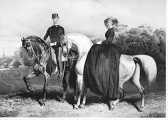
These horses bond very tightly with owners and are awesome family horse.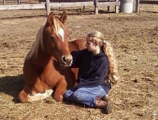 Melanie and Azzizah
Melanie and Azzizah
I needed a lot of help with this post, including Wikipedia, the site for the Arabian Horse Association also the Pyramid Society and Al Khamsa. Last but not least Evening Star Arabians.
The Arab is a small light horse with a high head and high croup. Many Arab Horses have 5 lumbar vertebra and 17 sets of ribs, one less than horses of other breeds.
[image error]
As a war horse the mares were ridden into battle because of their courage and mental strength. Personally, I always thought that would lead to many interesting battles during the crusades since Western European knights rode stallions.
The Arab started coming to Western Europe during the Crusades, when crusaders came home bringing this ‘new’ horse with them. That was around 1095. After that when the Ottoman Turks pushed into Hungary in 1529 they brought Arabians with them.
From there it went on to influence just about every breed in Europe with the possible exception of the Icelandic, since the stud book there was closed around the year 1000.
[image error]
Don't ride your horse this way, but even with a bad rider an Arab can do anything
There are several strains of Arab. Originally there were the Bedouin or Desert bred types
Kuhaylan: a masculine and strong strain of Bedouin Arab, thicker and stronger than the others I will write about in this section. They also have a quieter nature.
Hamdani: Taller and longer than the Kuhaylan, more refined but still very strong and masculine they are the desert strain with the highest endurance.
Abayyan: even more refined with a high carriage and the high forehead and tapered muzzle that we all think of as the typical Arab. It is more spirited than the Kuhaylan and the Hamdani.
Dahman: a medium sized horse with the refinement of the Abayyan and the strength of the Kuhaylan.
Seglawi: extremely refined, with a much more feminine look. These horses are fast but with less endurance than the other larger bloodlines
Got that?
Well it gets more complex:
Now we have the modern European and Colonial strains
Polish: the Polish strain of Arab is very refined and fast, still they are quite athletic. This strain has been effected by the wars in Europe quite a bit. Spanish: this strain of horse is known for its disposition,versatility and its big eyes. Crabbet: the Crabbet type is sturdy and sound and can be used and worked without worry about any kind of breakdown. They can be a bit plain and a bit larger than others. Russian: the goal of the breeders of this strain is to produce an animals that is pleasant to look at while being extremely athletic.
Egyptian: the Egyptian strain only contains bloodlines of the original desert types. The Egyptian strain is less than 2% of the Arabs registered in the US but hold 30% of the national titles. That says something. [image error] Azzizah an Egyptian Arabian Mare owned by Evening Star Arabians
Domestic: These animals are the descendants of animals imported before 1944. I would say this is a bit like the population of the US, mostly English (Crabbet) with other strains mixed in.
CMK: this strain is the combination of three studs lines the Crabbet/Maynesboro/Kellogg.
The various breed registries use genetic testing to a much higher extent than I am used to in horses. I’ve seen similar uses of blood testing in rare breed programs but while poking around for info for this blog I saw a lot of information on both genotype and mitochondrial DNA use. The use of mtDNA makes a lot of sense, since this breed is matrilineal.
With the Arab’s strong body, quick mind and great beauty it is one of the best Lady’s horse out there.

These horses bond very tightly with owners and are awesome family horse.
 Melanie and Azzizah
Melanie and AzzizahI needed a lot of help with this post, including Wikipedia, the site for the Arabian Horse Association also the Pyramid Society and Al Khamsa. Last but not least Evening Star Arabians.
Published on December 14, 2014 16:13
December 3, 2014
Holiday Hop

Bird's Christmas Carol is my favorite Christmas story of all time. It is the story of the youngest child of a rich family who is bedridden and is spending all her time arranging a good Christmas for a poor family.
It's not the sort of story that my friends think of when they think of me, it is a sweet story about a saintly child and it makes me cry every time.
The book was written and published in 1887 and was written by Kate Douglas Wiggin who also wrote Rebecca of Sunnybrook Farm and opened the first free kindergarten in San Francisco. The book is available On Guttenberg
Now go here to pin a picture of your favorite Christmas story to be entered to win a Kindle or a $25 Amazon gift card.
Leave a comment in this blog for a chance to win a thimble charm a pdf copy of one of my stories and an Amazon gift card.
Jamie Brumfield Amanda Bennett Michele Mathews Julia Mills Elizabeth Inglee Richards
Carol Ann Kauffman Jennifer Chambers Diane Rinella Angela Ford Terri Carle
Sharon Kleve Melanie James Mariah Dietz Serena Zane Jennifer Conner Amanda Bennett
R.E. Hargrave Ella Medler Aubree Lane Rebecca Sherwin Teri Riggs
Ava O'Shay Andie Lea Dzintra Sullivan Andrea Perno Jennifer Theriot Chris Karlsen
Al Parks L.A. Remenicky Emma Lee Skye A.L. Wood Jayne Hyatt Amber Daulton
Joanne Jaytanie Kelly Cozzone J.D. Hollyfield Patricia Kiyono Elle Klass
T.I. Lowe Tammy Tate Jackie Marilla Casey Harvell Denise Kawaii Natalie-Nicole Bates Kelly Ann Jacobson Moira Keith Michele Gwynn Tracey Alvarez Mary Bernsen
Published on December 03, 2014 17:41
November 30, 2014
Holiday Gifts of Love Blog Hop
Entry-Form
Celebrate the Wonder of the Holiday Season! Visit all of the blogs and answer this question, "What is your favorite Christmas Movie?" There's a giveaway at each stop so be sure to visit them all!
My favorite Christmas movie right now is Rare Exports a
');
Celebrate the Wonder of the Holiday Season! Visit all of the blogs and answer this question, "What is your favorite Christmas Movie?" There's a giveaway at each stop so be sure to visit them all!
My favorite Christmas movie right now is Rare Exports a
');
Published on November 30, 2014 07:54
Sorry for the long delay!
I was out of town with work. Every year the company I work for does a few retail shows. It is sort of an odd thing, you would think that they would be a heap of fun. I mean you go someplace and there are heaps of shopping opportunities and there are clinics about just about every type of horse and riding styles.
Mind you, what we see is our booth.
Even with that it can be a heap of fun. This year we had an awesome group. The two new people Gabby (a professional photographer, who I totally didn't get a website for) and Mel from Evening Star Arabians were both easy going and good traveling companions. Nothing to awful happened beyond issues with the credit card machine and unfortunately that is kinda normal.

Rhonda from Horsey Set Net stopped by and took this pic of me (it’s a good pic! I can be hard to photograph) with my helmets. I got to run through the breed barn and took pics of four breeds. You will be seeing most of those pics in the next month or so.
For the first time in what feels like forever I had fun at a show. I even came back with an idea for a business.
The trick to having a good time is good company - and we had super good company this time. That said, it still takes me what feels like a billion years before I come back to normal after a show.
Next post will be part of a blog hop and then there will be two posts about the Arab horse. That breed is way to much to handle in one post, so you will get a bonus post!
Liz
Mind you, what we see is our booth.
Even with that it can be a heap of fun. This year we had an awesome group. The two new people Gabby (a professional photographer, who I totally didn't get a website for) and Mel from Evening Star Arabians were both easy going and good traveling companions. Nothing to awful happened beyond issues with the credit card machine and unfortunately that is kinda normal.

Rhonda from Horsey Set Net stopped by and took this pic of me (it’s a good pic! I can be hard to photograph) with my helmets. I got to run through the breed barn and took pics of four breeds. You will be seeing most of those pics in the next month or so.
For the first time in what feels like forever I had fun at a show. I even came back with an idea for a business.
The trick to having a good time is good company - and we had super good company this time. That said, it still takes me what feels like a billion years before I come back to normal after a show.
Next post will be part of a blog hop and then there will be two posts about the Arab horse. That breed is way to much to handle in one post, so you will get a bonus post!
Liz
Published on November 30, 2014 07:08
November 22, 2014
November 9, 2014
blog-cation
Well not a vacation, but more of an excuse.
It's that magical 'I just can't get anything done' time of the year, but I'll be back at it soon.
It's that magical 'I just can't get anything done' time of the year, but I'll be back at it soon.
Published on November 09, 2014 08:30
October 22, 2014
Barb, easily confused?
We think of this as a Spanish breed but the Barb comes from North Africa. When brought to Europe they were confused with a Middle Eastern breed, the Arab, because the owners of both breeds were mostly Arabic speakers.
[image error]The Barb
As someone mostly descended from Northern Europeans I find that really embarrassing.
Barbs are small horses, mostly under 15.2 (62 inches) with a high head and withers and a sloping croup with a straight shoulder.
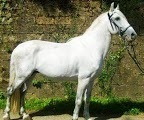
It doesn’t look anything like an Arab.
[image error]The Arab
The Barb isn’t known for strong gaits but is a fantastic sprinter and has been used to develop Thoroughbreds Standardbreds. The Barb and Jennet were both influential in the development of Quarter Horses, Appaloosa and the Mustang.
[image error]The Barb
As someone mostly descended from Northern Europeans I find that really embarrassing.
Barbs are small horses, mostly under 15.2 (62 inches) with a high head and withers and a sloping croup with a straight shoulder.

It doesn’t look anything like an Arab.
[image error]The Arab
The Barb isn’t known for strong gaits but is a fantastic sprinter and has been used to develop Thoroughbreds Standardbreds. The Barb and Jennet were both influential in the development of Quarter Horses, Appaloosa and the Mustang.
Published on October 22, 2014 14:17
October 1, 2014
Jennet; with legs tucked up
I’ll be honest, I should have done the Jennet earlier or maybe later. I’ve mentioned the Jennet a few times. This is a small European war horse and to the eye it looks a lot like the Baroque horses. This horse is gated and is often spotted.
[image error]
The Jennet (both modern and medieval) is known as a comfortable ride and it was great for riding distances and as a fast small cavalry and lancer horse. These horses were ridden with shorter stirrups legs tucked up “à la jineta” or Jennet.
The modern breeds that was most like the medieval breed are the modern Spanish Jennet and the Paso breeds, the Peruvian Paso and the Paso Fino.
Here is a modern Jennet doing his Paso Fino.
Here is a class of Paso Finos doing their fine gate.
Here is the Spanish Jennet horse society
[image error]
The Jennet (both modern and medieval) is known as a comfortable ride and it was great for riding distances and as a fast small cavalry and lancer horse. These horses were ridden with shorter stirrups legs tucked up “à la jineta” or Jennet.
The modern breeds that was most like the medieval breed are the modern Spanish Jennet and the Paso breeds, the Peruvian Paso and the Paso Fino.
Here is a modern Jennet doing his Paso Fino.
Here is a class of Paso Finos doing their fine gate.
Here is the Spanish Jennet horse society
Published on October 01, 2014 17:30
September 23, 2014
Akhal-Teke the mythic Golden Turk
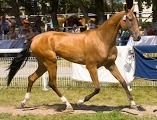
The Akhal-Teke is the horse of Turkmenistan. It is a horse of great speed and endurance. The breed started as sort of a Landrace. It was a raiding horse until 1881 Russia took over Turkmenistan and the Akhal-Teke was used in the failing war to keep that from happening. The horses were so tough and fast that the Russians called The Divine Horse.
No one knows the exact origin of this horse, like many of the really old breeds. The people of Turkmenistan kept oral records until the 30’s when the Russian’s closed the studbook. This horse is often a golden palomino or a golden buckskin. The breed carries the cream dilution gene. That is exactly what it sounds like, it dilutes the horses coat color.
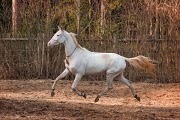
We will talk a bit more about this breed when we get to the Thoroughbred as the Byerly, Lister, White and Yellow Turks, all important and foundation sires the Thoroughbred may have been Akhal-Teke. The breed may have introduced Naked Foal Syndrome, a fatal genetic disorder, as well as cervical vertebral malformation, (CVM causes a horse to ‘wobble’) to the Thoroughbred breed.
I have, in the past, mentioned the race from Ashkabad to Moscow in 1935, a distance of over 2000 miles an incredible distance to race over.
There are only around 6000 of these horses world wide and the Turkmenistan government uses them as diplomatic gifts.
Here is an in hand class of young Akhal-Teke
Published on September 23, 2014 08:58
September 17, 2014
Horse of the horde
Here is another tiny war horse. It seems like if the world called you a ‘Hoard’ you ride around on small little things.
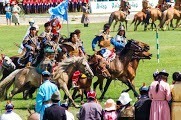
The Mongol horse is small and stocky it isn’t as fast as some other horses but is extremely hearty and sure footed. The horse stands 12 to 14 hands high (48 to 56 inches) Warriors often rode lactating mares because the milk is a food source. Like the Icelandic this breed moves with a high head. The Mongol may be the oldest of all the breeds and has the highest genetic diversity of all domestic horses.
These horses are still ‘free breeding’, basically the horses live in herds and choose who they breed with. People say that if you need a horse from the herd they just pull one out of the herd and tack it up and ride it - I don’t know if that is true or not. This breed was the basis for the Scandinavian breeds and they went on to influence… well I have a post about that.
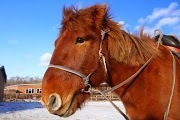
The Mongolian is a Landrace. A Landrace is a type of animal that develops in an area and is evolved to fit the environment it lives in. They can be formalized into a breed, like the Icelandic, or they can be informal. The Mongolian, the Mustang, and the Exeter are all examples as informal landrace, although I know that there are registries for Mustangs and Exeters. When a Landrace gets formalized as a breed they lose a lot of genetic diversity. That is what happens when we humans control things.
The Mongolian may be the most important breed of all time because of the breeds that sprung from it, as well as the whole hoard thing.
Funny thing about the Mongolian and the Icelandic, if you read the saga of the Burgundians (you know it from the Wagner operas and the Ride of the Valkyrie) the daughter of one of the Nordic kings married Attila the Hun. Now we know, genetically, those horses are related so you never know.
Published on September 17, 2014 16:33



